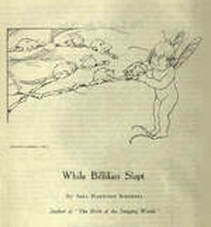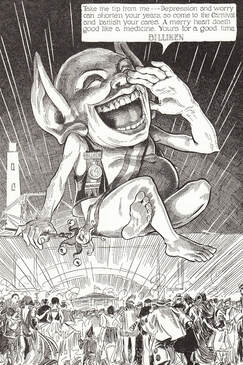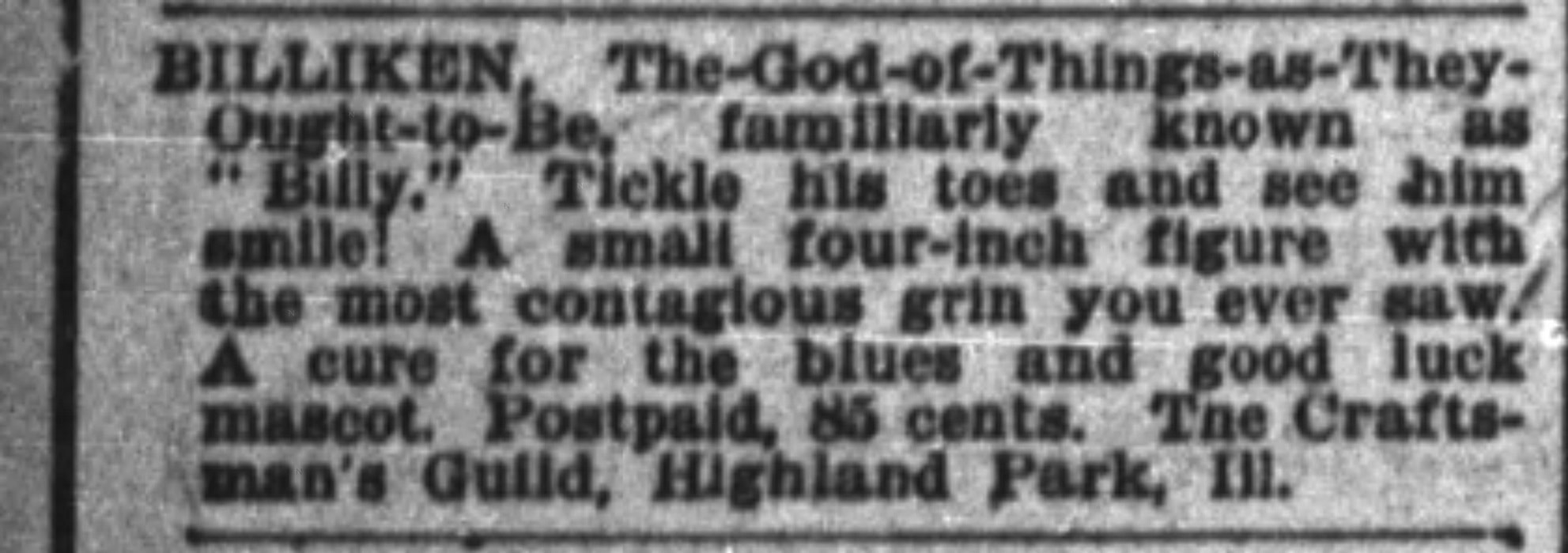 By M.P. Pellicer | Stranger Than Fiction Stories Florence Pretz a native of Kansas City held the design patent for a slant-eyed pudgy figure granted on October 6, 1908, known as the Billiken. Little did she imagine it would inspire a cult-like following.  The original rendering of the Billiken The original rendering of the Billiken The Billiken appeared in The Canada West, A Magazine of the Sunset Provinces in 1907. For 8 months the Billiken appeared in five Canada West stories, written by Sara Hamilton Birchall and illustrated by Florence Pretz. They were both friends who hailed from Kansas City, and moved to Chicago. Birchall took her inspiration from the Bliss Carman poem, Mr. Moon, A Song of the Little People published in 1896. The fairy-like being was made into the God of Things As They Ought To Be.  The Billiken gained instant popularity soon after its introduction in the United States The Billiken gained instant popularity soon after its introduction in the United States A full page ad in Chicago brought to the American public the Billiken as the mascot of good luck. Florence Pretz was pictured, dressed in a kimono and burning incense to her Billiken statue. She had once been an art teacher at the Manual Training High School in Kansas City. Florence had been drawing Japanese sketches since she was a young girl, which led to the belief her inspiration for the Billiken was Oriental. Pretz told the newspapers she had molded him out of clay and then cast him in plaster. Both her, and her friend Sara Birchall had began to burn incense before him and worshipping him, and soon good luck came their way. Her friend set up the statue of "Billy" in her bachelor girl flat after moving to Chicago. She worked as a stenographer, but soon had her poems published in a small book titled The Book of the Singing Winds.  An early advertisement for the BIlliken c.1909 An early advertisement for the BIlliken c.1909 The naivete that perhaps inspired Florence Pretz with her design of the pudgy fairy, worked against her in ways she could never have imagined. The Billiken Company was incorporated with $60,000 worth of capital stock in the State of Illinois on September 24, 1908, by three men: Charles P. Monash, Toby Rubovits and James Rosenthal. It seems that real money, and the real luck came to them with the sale of the Billiken. The little statue was soon being sold by the hundreds at arts and crafts shops, candy shops and art shows. The story behind the advertising pitch was that Florence "Tinker Bell" Pretz came to Chicago to work with her friend in a studio in Highland Park, and both friends would without fail burn incense to the Billiken statue every night. However, within a year and a half of the Billiken craze Florence Pretz made the headlines by casting her little idol off since he no longer brought her luck. She had agreed to sell the right to the Billiken patent for only $30 per month, never expecting the thousands of dollars it would generate once it was publicized by the Billiken Company. She had become so bitter that she said she would "go out of her way than to see a Billiken Throne, a Billiken pin, cuff buttons or anything else that is based on a Billiken model." She said she would smash a statue of Billiken if given a chance. Luck did visit her once more on Valentine's Day, 1912, when she married Robert A. Smalley and the couple moved to Nebraska.  Statue of Billiken in Japan Statue of Billiken in Japan It seemed that in a few short months, a cult of Billiken believers had flourished. It spread beyond the United States to all over the world. In 1909 the Billiken was carved by an Inuit carver in ivory, and by the 1960s the little figure was ubiquitous in major Alaskan cities. In 1911, the Majestic Theater in Illinois ran an ad asking "Please return Billiken bad luck will follow the person that took him". No doubt the theft of the statue was due to the belief that to buy a Billiken was said to give the purchaser luck, but to receive one as a gift would be better luck. The best luck though was if you stole it. The custom was to rub the statue's feet or stomach to manifest the good fortune. The Billiken appeared in Japan in 1908, after it debuted in the United States. Images of Billiken was enshrined in different cities in Japan. In Kansai's (Osaka) Geisha community they were carried as symbols of good luck. In 1912, the wooden statue was displayed at the Usutenkaku Tower. The Billiken became the unofficial mascot of Osaka. That same year a shrine to Billiken was opened in Luna Park a famous amusement park in Osaka. In 1923, the statue mysteriously disappeared, and it has never been found.  The Billiken became a "carnival god" in the Phillipines The Billiken became a "carnival god" in the Phillipines In the Philippines the Billiken was transformed to the pre-Lenten season "carnival god" and used in the Manila Carnival. This event coincided with Mardi Gras events celebrated around the world by Catholic countries. The first carnival was commenced in 1908. At least two Billiken-themed songs were recorded, including Billiken Rag and the Billiken Man Song. It was rumored that L. Frank Baum the author of the Wizard of Oz kept a Billiken in his office. During those years, the Billiken became the official mascot of Saint Louis University and St. Louis University High School, both Jesuit institutions located in St. Louis. It remains their mascot present-day.  Florence Pretz Smalley tried to recreate the success of the Billiken with a Pot Hound but it never took off c.1922 Florence Pretz Smalley tried to recreate the success of the Billiken with a Pot Hound but it never took off c.1922 The Billiken also became the official mascot of the Royal Order of Jesters organized in 1911. It is an all male, by invitation only Shriner group, affiliated with Freemasonry. In 1922, Florence who now resided in California debuted a new creation known as the Pot Hound. She worked as an illustrator at Bullock's department store. She intended to put out the Pot Hound as an ash tray with a bone thrown in the pot tray for luck. They were being offered to the public via Bullocks. Unlike the Billiken the plaster figures never took off. The Billiken, as a good luck charm, appears multiple times in the Vivien Leigh and Robert Taylor movie Waterloo Bridge (1940).  The Billiken caused Davy McKee to end up in an insane asylum c.1909 The Billiken caused Davy McKee to end up in an insane asylum c.1909 But for all cheery stories of the Billiken it's inescapable that there would be some with a darker angle. In 1909, the Optimist Club in Salt Lake City used the little image as a genius. Members of the club included presidents, cabinet members and captains of industry. The in-house Billiken flashed the message: "God reigns, the Union still lives and the sun shines, even though the clouds obscure it. Go bury thy sorrow; the world has its share. Just smile." Many dismissed the Billiken as a fad, but not all. One of them was an Irish man named David McKee. There was no good luck for him, because in 1909 he was locked away in the Home for the Insane in New York. He wanted to write letters of warning to Taft, Roosevelt and Carnegie. All he would mutter was, "Billiken — Billiken — Billiken." Years before while still living in Ireland, Davy McKee met William J. Robinson who would become head of the Optimist Club in Salt Lake City. Upon arriving in America, McKee attached himself to the organization in Salt Lake City, and was sent to the New York office to work there. McKee belonged to the YMCA, taught Sunday school and was active in church work in Ireland. When he arrived in New York, the Optimist Club was selling the figurine for a $1 each, and he saw $200 a day coming in for the sales of the Billiken. Somehow seeing that the Billiken was indeed only a plaster statue with no magical powers did something to him, as he believed it actually had powers to bring good luck through optimism. What became of Davy McKee is unknown. Florence the Billiken's creator died in 1969, at the age of 83.
0 Comments
Your comment will be posted after it is approved.
Leave a Reply. |
Stranger Than Fiction StoriesM.P. PellicerAuthor, Narrator and Producer Archives
July 2024
Categories
All
|
Stories of the Supernatural
- Stories of the Supernatural
- Miami Ghost Chronicles
- M.P. Pellicer | Author
- Stranger Than Fiction Stories
- Eerie News
- Supernatural Storytime
-
Astrology Today
- Tarot
- Horoscope
- Zodiac
-
Haunted Places
- Animal Hauntings
- Belleview Biltmore Hotel
- Bobby Mackey's Honky Tonk
- Brookdale Lodge
- Chacachacare Island
- Coral Castle
- Drayton Hall Plantation
- Jonathan Dickinson State Park
- Kreischer Mansion
- Miami Biltmore Hotel
- Miami Forgotten Properties
- Myrtles Plantation
- Pinewood Cemetery
- Rolling Hills Asylum
- St. Ann's Retreat
- Stranahan Cromartie House
- The Devil Tree
- Trans-Allegheny Lunatic Asylum
- West Virginia Penitentiary
- Paranormal Podcasts
"When misguided public opinion honors what is despicable and despises what is honorable, punishes virtue and rewards vice, encourages what is harmful and discourages what is useful, applauds falsehood and smothers truth under indifference or insult, a nation turns its back on progress and can be restored only by the terrible lessons of catastrophe."
- Frederic Bastiat
- Frederic Bastiat

Copyright © 2009-2024 Eleventh Hour LLC. All Rights Reserved ®
DISCLAIMER
DISCLAIMER




 RSS Feed
RSS Feed
















